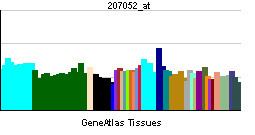Entrez 26762 | Ensembl ENSG00000113249 | |
 | ||
Aliases HAVCR1, HAVCR, HAVCR-1, KIM-1, KIM1, TIM, TIM-1, TIM1, TIMD-1, TIMD1, CD365, hepatitis A virus cellular receptor 1 External IDs HomoloGene: 134424 GeneCards: HAVCR1 | ||
Hepatitis A virus cellular receptor 1 (HAVcr-1) also known as T-cell immunoglobulin and mucin domain 1 (TIM-1) is a protein that in humans is encoded by the HAVCR1 gene.
Contents
The hepatitis A virus cellular receptor 1 (HAVCR1/TIM-1), is a member of the TIM (T cell transmembrane, immunoglobulin, and mucin) gene family, which plays critical roles in regulating immune cell activity especially regarding the host response to viral infection. TIM-1 is also involved in allergic response, asthma, and transplant tolerance.
The TIM gene family was first cloned from the mouse model of asthma in 2001. Subsequently it was demonstrated that members of the TIM gene family including TIM-1 participate in host immune response. The mouse TIM gene family contains eight members (TIM-1-8) while only three TIM genes (TIM-1, TIM-3, and TIM-4) have been identified in humans.
Structure and function
TIM genes belong to type I cell-surface glycoproteins, which include an N-terminal immunoglobulin (Ig)-like domain, a mucin domain with distinct length, a single transmembrane domain, and a C-terminal short cytoplasmic tail. The localization and functions of TIM genes are divergent between each member. TIM-1 is preferentially expressed on Th2 cells and has been identified as a stimulatory molecule for T-cell activation. TIM-3 is preferentially expressed on Th1 and Tc1 cells and function as an inhibitory molecule, which mediated apoptosis of Th1 and Tc1 cells. TIM-4 is preferentially expressed on antigen-presenting cells, modulating the phagocytosis of apoptotic cells by interacting with phosphatidylserine (PS) exposed on apoptotic cell surface.
Role in viral infection
TIM genes are also involved in host-virus interaction. As receptors for phosphatidylserine, TIM proteins bind many families of viruses [filovirus, flavivirus, New World arenavirus and alphavirus] that include viruses such as dengue and ebola. Interestingly entry of Lassa fever virus, influenza A virus, and SARS coronavirus were not affected by TIM-1 expression. TIM-1 and TIM-4 enhanced viral entry more than TIM-3.
Hepatitis A
TIM-1 has been identified as the cellular receptor of hepatitis A virus (HAV). The mucin domain and IgV domain were critical for virus uncoating and infectivity. By using an expression cloning library, IgA has been demonstrated as a specific ligand of TIM-1. The association of TIM-1 and IgA was able to enhance the virus-receptor interaction.
Ebola
Recently, TIM-1 has been shown to be a receptor or cofactor for Ebola virus entry. TIM-1 binds to Ebola virus glycoproteins (GP) and mediates Ebola virus cellular entry by increasing Ebola virus infectivity in poorly permissive cell lines. Moreover, reducing expression of endogenous TIM-1 in highly permissive cell lines decreased Ebola virus infectivity. Furthermore, TIM-1 IgV domain specific antibody ARD5 inhibited Ebola virus infectivity, indicating that TIM-1 was critical for Ebola virus entry. Also, TIM-1 expression on human mucosal epithelial cells from the trachea, cornea and conjunctiva demonstrated the correlation of TIM-1 expression feature and viral entry routes.
Dengue
TIM-1 has been identified as a cellular factor for Dengue virus entry by overexpression of TIM-1 on poorly susceptible cell lines for Dengue virus infection. TIM-1 enhanced dengue virus infectivity by 500-fold, particularly increased virus internalization. TIM-1 directly interacted with Dengue virus particle by recognizing PS on the virion surface. In addition, the Dengue virus susceptibility of different cell lines was consistent with endogenous expression level of TIM-1 gene in such cell lines, suggesting that TIM-1 is crucial for Dengue virus entry.
